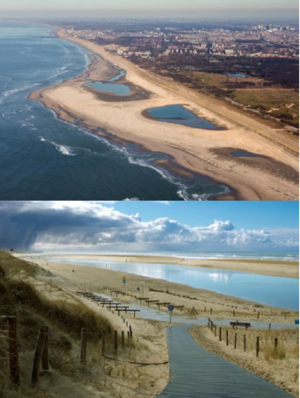PR 00296: verschil tussen versies
(Nieuwe pagina aangemaakt met ' {{Project config}} {{Project |Name=C-SCAPE: Sandy strategies for sustainable coastal climate change adaptation Living Labs in the Dutch Delta |Supercontext=Buildi...') |
Geen bewerkingssamenvatting |
||
| (5 tussenliggende versies door 2 gebruikers niet weergegeven) | |||
| Regel 1: | Regel 1: | ||
[[Bestand:C-SCAPE.png|miniatuur|The test locations of C-SCAPE, the Sandmotor Delfland at the top and Hondsbossche Dunes at the bottom.]] | |||
The narrow strip of beach and dunes form an important part of the coastal protection system around the world. Even though it only makes up about 4% of the earths total landmass. They protect the hinterland from flooding, provide freshwater filtration and storage services and add unique wetlands and landscapes which provide many touristic and recreational functions. However, these areas are experiencing heavier erosion each year. Therefore, innovative measures created by the Building with Nature and Living Shorelines philosophies will be put to use in order to halt and reverse ongoing erosion. | |||
The solution proposed is the addition of sand suppletions to areas that show high erosion rates. The volume of the nourishments is determined by predicting the erosion rate on current knowledge gained by monitoring. Two large-scale nourishment projects have been created (Sandmotor and Hondsbossche Dunes) and form the living labs for the project C-SCAPE. Examining natural and anthropogenic drivers of the coastal landscape is the key to high quality data on erosion and effectiveness of the sand suppletions. On the two locations not only physical experiments will be done, but also societal factors will be taken into account. | |||
The objective of C-SCAPE is to develop the knowledge and tools needed to assess the feasibility and benefits of sandy strategies for coastal climate adaptation. | |||
'''Research type:''' field research, desk analysis, lab research | |||
'''Location:''' Sandmotor Delfland and Hondsbossche Dunes | |||
'''Contact:''' {{External link|resource=Resource Hyperlink 00705|name=Joost Stronkhorst|dialog=process-linkwebsite-dialog}} | |||
{{Project config}} | {{Project config}} | ||
{{Project | {{Project | ||
|Name=C-SCAPE: Sandy strategies for sustainable coastal climate change adaptation | |Name=C-SCAPE: Sandy strategies for sustainable coastal climate change adaptation | ||
|Supercontext=Building with Nature | |Supercontext=Building with Nature | ||
|Start date=2019/10/01 | |Start date=2019/10/01 | ||
|End date=2024/10/31 | |End date=2024/10/31 | ||
|Summary= | |Summary=Sand suppletions are one of the most important and most used techniques against flooding. While offering protection, they also form unique opportunities for nature and civilization. Due to climate change a heavy increase in the volume of sand suppletions is visible. The living labs are focused on two large scale projects focusing on coastal protection (the sandmotor and Hondsbossche Duinen). Within these living labs additional measurements will be taken in order to give better insight into the morphological, ecological and societal effect of large scale sand suppletions in order to design better flood protection measurements in the future. | ||
Research type: field research, desk analysis, lab research | |||
|Show summary=Nee | |Show summary=Nee | ||
|Contact person=Gebruiker:Stronkhorst | |Contact person=Gebruiker:Stronkhorst | ||
|Stakeholder= | |Stakeholder=STKH 00070,STKH 00061,STKH 00073,STKH 00071,STKH 00072 | ||
|Show extra=Nee | |Show extra=Nee | ||
|Show navigation tree=Ja | |Show navigation tree=Ja | ||
Huidige versie van 27 mrt 2020 om 13:34
The narrow strip of beach and dunes form an important part of the coastal protection system around the world. Even though it only makes up about 4% of the earths total landmass. They protect the hinterland from flooding, provide freshwater filtration and storage services and add unique wetlands and landscapes which provide many touristic and recreational functions. However, these areas are experiencing heavier erosion each year. Therefore, innovative measures created by the Building with Nature and Living Shorelines philosophies will be put to use in order to halt and reverse ongoing erosion.
The solution proposed is the addition of sand suppletions to areas that show high erosion rates. The volume of the nourishments is determined by predicting the erosion rate on current knowledge gained by monitoring. Two large-scale nourishment projects have been created (Sandmotor and Hondsbossche Dunes) and form the living labs for the project C-SCAPE. Examining natural and anthropogenic drivers of the coastal landscape is the key to high quality data on erosion and effectiveness of the sand suppletions. On the two locations not only physical experiments will be done, but also societal factors will be taken into account.
The objective of C-SCAPE is to develop the knowledge and tools needed to assess the feasibility and benefits of sandy strategies for coastal climate adaptation.
Research type: field research, desk analysis, lab research
Location: Sandmotor Delfland and Hondsbossche Dunes
Contact: Joost Stronkhorst

